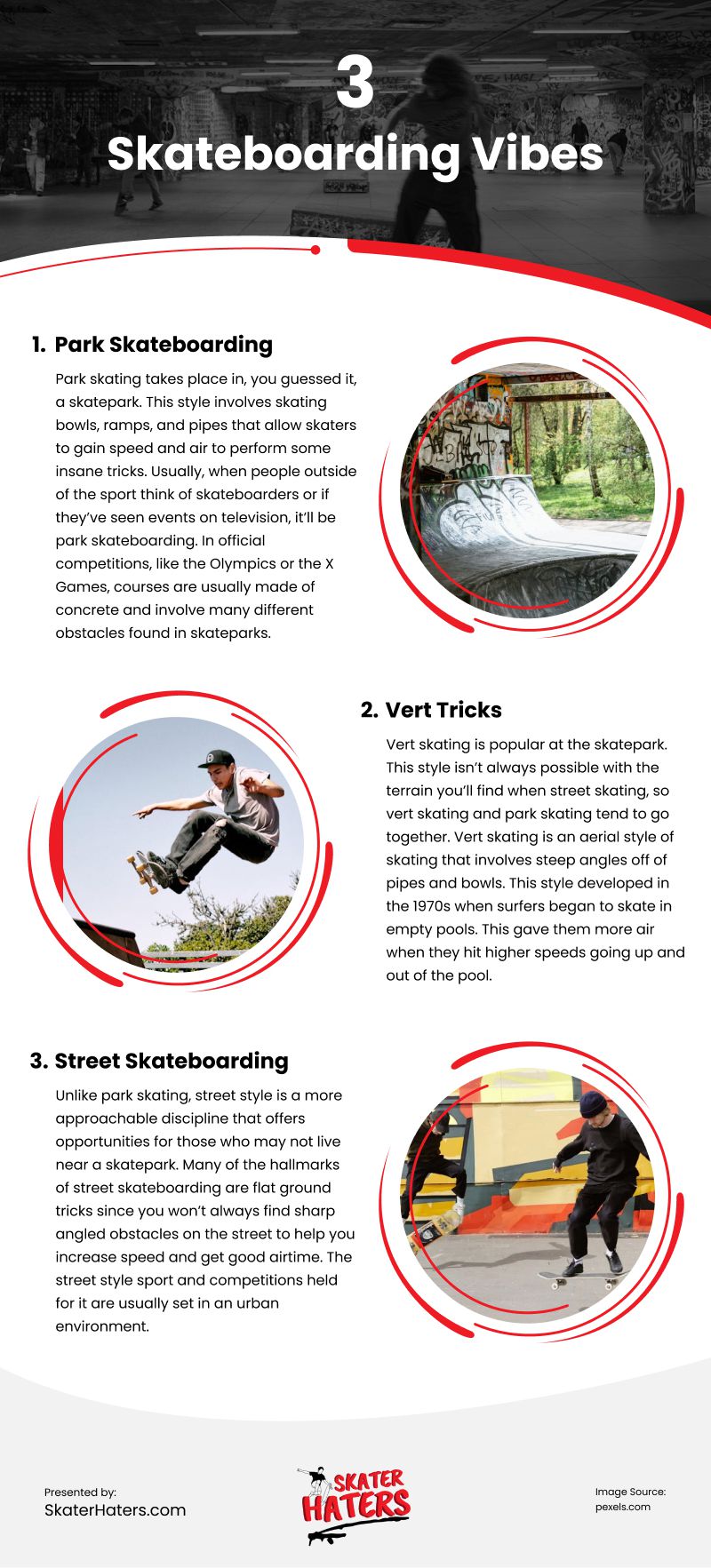The two big styles of skateboarding are street skating and park skating. With the Olympics coming up we should note that both of these popular forms will be included in the games, and you’ll be able to catch some of the best examples in the world of both.
If you’re thinking about trying out some new things on your board or having a hard time deciding which style to focus on, we’ve highlighted some of the differences to help you figure out your vibe.

(Ana Arantes/pexels)
Don’t forget though that skate culture is all about forging your own path and doing your own thing, so you shouldn’t feel like you have to commit to only one or the other. Combining moves across the board can be a fun way to develop your own unique skating style. Who knows, maybe someday you’ll even end up an Olympic skateboarder.
Park Skateboarding
Park skating takes place in, you guessed it, a skatepark. This style involves skating bowls, ramps, and pipes that allow skaters to gain speed and air to perform some insane tricks. Usually, when people outside of the sport think of skateboarders or if they’ve seen events on television, it’ll be park skateboarding. In official competitions, like the Olympics or the X Games, courses are usually made of concrete and involve many different obstacles found in skateparks.
This discipline often draws in thrill seekers looking for that rush of adrenaline. The high speeds, big air, and vert tricks–the ones taking place on steep angles, all offer a chance to get your heart pumping.
Park skateboarding also gives skaters the opportunity to find community. Other skaters at your local skatepark can be a great source of encouragement and support. One way to fit in and make new skateboarding friends is to look the part in cool youth skate clothes. As a park skater you’ll need lots of practice on the skatepark obstacles and you’ll be spending lots of time there.
Vert Tricks
Vert skating is popular at the skatepark. This style isn’t always possible with the terrain you’ll find when street skating, so vert skating and park skating tend to go together.
Vert skating is an aerial style of skating that involves steep angles off of pipes and bowls. This style developed in the 1970s when surfers began to skate in empty pools. This gave them more air when they hit higher speeds going up and out of the pool.
Common vert tricks include the McTwist, spins like the full or half-cab, and the ever impressive Madonna. These tricks can be, well, tricky, but look amazing if you get them right.
Vert tricks are high-risk, high-reward skills that, if performed wrong, may cause serious injury. In addition to your helmet, elbow and knee pads, wrist guards are essential if you want to try these tricks. Even the greatest vert and park skaters wear the proper protective gear, from Bob Burnquist to Tony Hawk.
Street Skateboarding
Unlike park skating, street style is a more approachable discipline that offers opportunities for those who may not live near a skatepark. Many of the hallmarks of street skateboarding are flat ground tricks since you won’t always find sharp angled obstacles on the street to help you increase speed and get good airtime.
The street style sport and competitions held for it are usually set in an urban environment. Even if the competition is intentionally set up for skateboarders, you will generally find obstacles like the ones you see around your own town. Rails, stairs, ledges, and curbs are the basis for most of the tricks in street skateboarding.
Street style developed as skaters began looking for opportunities to skate outside the empty pools where vert skating and park style were born. In cities and urban landscapes, skaters were able to express themselves and practice the sport they loved without the structure of a bowl or pipe.
Street style has become the definition of chill, laid-back skating, which is emphasized by the fashion styles of baggy skate clothes, cool skater boy shirts and hoodies, and classic oversized girls skate apparel. Skateboarding fashion has been present for decades, with baggy fits popular at every age.
Street skateboarding moves are almost entirely based around the ollie. The classic ollie takes your board off the ground and into the air without the need to gain speed on a ramp. Mastering this trick is crucial to success.
If you like the freedom to skate wherever you find a smooth surface and the challenge of creating your own obstacles to perform tricks on, street skateboarding may be right up your alley. Street style is more chilled-out but still offers a ton of room for creativity and learning more advanced tricks without the need to find a fully equipped skatepark.
Video
Infographic
If you’re having trouble deciding which style to focus on or want to try out new things on your board, check out this infographic. It highlights some differences to help you figure out your vibe.

